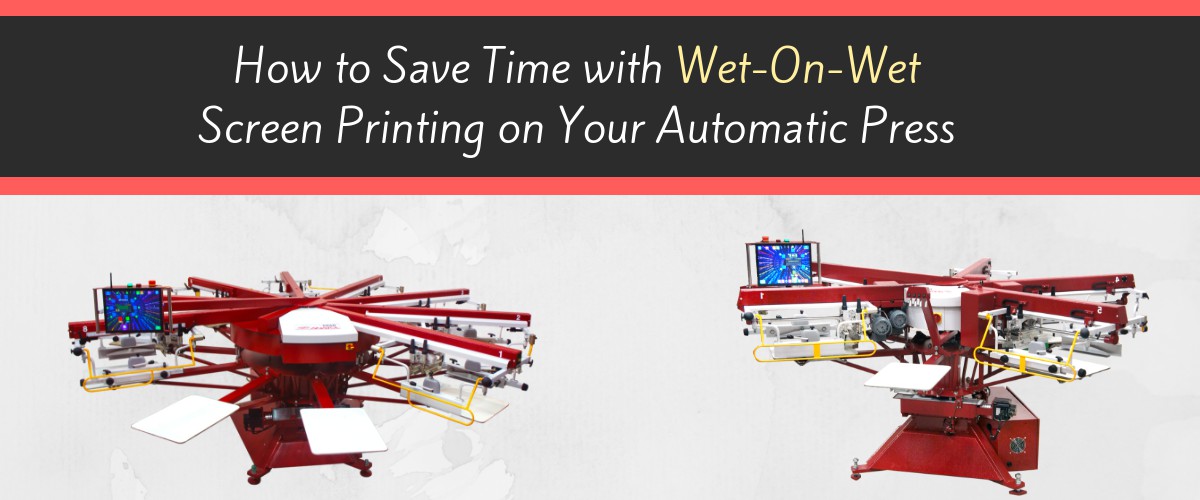

Революция в индустрии трафаретной печати благодаря передовым технологиям и качественному обслуживанию
Anatol Equipment Manufacturing Co.
1429 S Shields Dr
Waukegan, IL 60085


Революция в индустрии трафаретной печати благодаря передовым технологиям и качественному обслуживанию
Anatol Equipment Manufacturing Co.
1429 S Shields Dr
Waukegan, IL 60085

Most screen printers are looking for ways to increase production speed while maintaining quality. Printing wet-on-wet allows you to do just that! With wet-on-wet screen printing, you don’t have to add minutes to your production time by flashing in between each color.
Wet-on-wet screen printing with an automatic screen printing press can provide some challenges. If you don’t take precautions before and during printing, your screens likely will pick up wet ink from your substrate, ruining your stencils and muddling your printing colors. Here are some tips for screen printing wet-on-wet with your automatic press:
All of your press runs should begin with a check of your press, but this check is especially important when you’re printing wet-on-wet. Be sure that your press’s print heads and your pallets are flat, level and firmly in place. If they are lifting and shifting during printing, or if they are at odd angles, your stencils won’t line up perfectly during printing and the edges of your ink will smudge and bleed into one another. You might also want to increase your press’s off contact. A higher off contact will allow your screen to snap away from your print more cleanly, making it less likely to pick up wet ink that already has been laid down. For the same reason, make sure that your screens are adequately tensioned.
There is a right order in which to print your inks wet-on-wet to reduce the risk of ink pick up. While there are always exceptions to the rule, convention calls for laying down your lightest ink color first and working your way to the darkest color. You also should lay down the ink color with the smallest footprint first and work your way toward the largest ink deposit.
Of course, if you are laying down an underbase for your print, you will need to flash cure this before you proceed with printing wet-on-wet. One common mistake printers make is that they fail to allow enough time for their flashed underbase to cool before laying down their first print color, which can lead to ink buildup on your screens. Some screen printers will add an empty station or two after the flash cure to provide cooling time. If this isn’t an option due to your press configuration, you can employ a cooling fan (just be careful not to blow dust into your prints).
For more info on good techniques to use while screen printing underbase layers, check out The Tricky Business of Screen Printing Underbase
One of the reasons screens will pick up ink when printing wet-on-wet is that too much ink is being laid down on the substrate. A lighter ink deposit will lead to less buildup. Use a higher mesh count screen — 200 or above — and a higher durometer squeegee to deposit less ink. Be sure that your squeegee isn’t exerting too much pressure on your screen. If your ink is too thick, it can cause you to put too much force on your screens during printing. If this is the case, consider using an ink reducer to lower the ink’s viscosity and allow it to flow through your screen mesh more easily. You also can look for inks that are specifically formulated for wet-on-wet screen printing.
Check out more tips on selecting the right mesh count and squeegee for your print job:
Screen Printing 101: Choosing the Right Mesh Count
Choosing the Right Squeegees for Your Screen Printing Jobs
Some screen printers will use a silicone spray when printing wet-on-wet with an automatic to prevent ink from building up on the screen. A silicone spray can help prevent ink from sticking to the screen, but it also can muddle prints so it should be used with caution.
Screen printing wet-on-wet can save you time, increasing your production efficiency and your shop’s earning potential. By using a few tips, you can successfully and confidently use your automatic press to print wet-on-wet.
Your message was successfully sent!